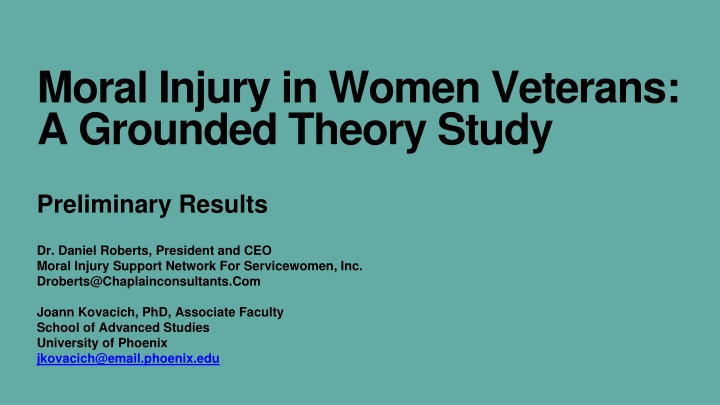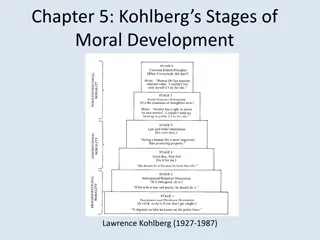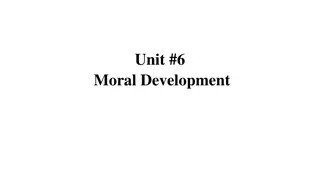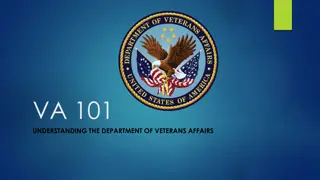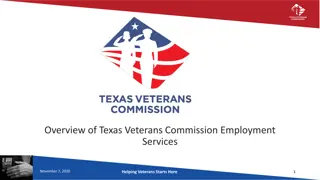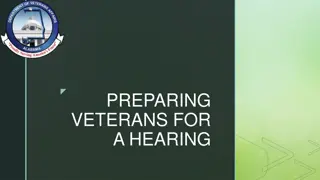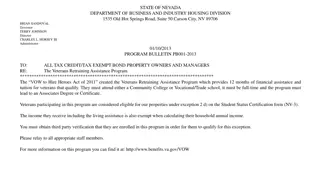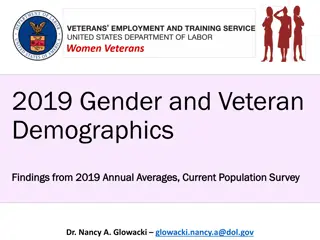Insights on Moral Injury Among Women Veterans: Preliminary Study Findings
Preliminary results from a grounded theory study on moral injury in U.S. women veterans reveal themes such as sexual assault, hostile work environments, and more. Participants shared their experiences, highlighting the nature of moral injury they faced, distinguishing between various forms of discrimination and trauma. The study delves into demographics, events associated with moral injury, and key themes identified, shedding light on the challenges women veterans encounter post-military service.
Download Presentation

Please find below an Image/Link to download the presentation.
The content on the website is provided AS IS for your information and personal use only. It may not be sold, licensed, or shared on other websites without obtaining consent from the author.If you encounter any issues during the download, it is possible that the publisher has removed the file from their server.
You are allowed to download the files provided on this website for personal or commercial use, subject to the condition that they are used lawfully. All files are the property of their respective owners.
The content on the website is provided AS IS for your information and personal use only. It may not be sold, licensed, or shared on other websites without obtaining consent from the author.
E N D
Presentation Transcript
Moral Injury in Women Veterans: A Grounded Theory Study Preliminary Results Dr. Daniel Roberts, President and CEO Moral Injury Support Network For Servicewomen, Inc. Droberts@Chaplainconsultants.Com Joann Kovacich, PhD, Associate Faculty School of Advanced Studies University of Phoenix jkovacich@email.phoenix.edu
Research Question: What is the nature of moral injury for U.S. women veterans? The following are reported events: Associated with the question of moral injury Not necessarily considered morally injurious at the time of the event or in and of themselves Participants made clear distinctions between sexism, racism, harassment, moral dilemmas, and moral injury
Demographics 47 Participants 16 Telephone interviews 31 Online Anonymous surveys Age at interview: mean: 55, youngest: 32, oldest: 72 Age when joined military: mean: 22, oldest: 43, youngest: 18 Date joined military: earliest: 1972, latest: 2015
Demographics Cont. Left the military: earliest: 1977, latest: 2020 Years of service: mean: 15, most: 40, least: 2 Officer ranks: highest: O6 (colonel or Navy captain), lowest: O1 (2nd lieutenant or Navy ensign) Enlisted rank: highest: E9 (sergeant major or Navy master chief petty officer), lowest: E4 (specialist or Navy petty officer third class) All service branches represented except the Coast Guard
Themes Sexual Assault Violating Own Morals Hostile Work Environment Hearing of Others Sexual Misconduct Gender Harassment Impossible Choice Retaliation Unfair System Combat and Occupation Lack of Integrity Betrayal
Sexual Assault 27 Participants (57%) Sexual assault (21) Victim Blaming (3) Unwanted touching (2) Orchestrated sexual assault (1)
Hostile Work Environment 25 Participants (53%) Sexual harassment (14) Mistreatment of homosexuals (1) Organizational trauma (6) Administrative trauma (1) Humiliation (3) Racism and misogyny (2) No advocate (1) Toxic leadership (2) Denied basic service rights (1)
Gender Harassment 15 Participants (32%) It is wrong to be a woman (4) Gender harassment (10) Women are just entertainment (3) Dismissive of rank (1)
Retaliation 6 Participants (13%) Retaliation for reporting sexual harassment and assault (4) Retaliation for not returning sexual advances (3)
Lack of Integrity 6 Participants (13%) Hypocrisy (2) Disclosing classified information (1) Good ol boys network (1) Using position of trust for personal gain (1) Asked to violate regulations (1)
Combat and Occupation 5 Participants (11%) Killing civilians with drones (1) Threatening Iraqi civilians (1) No ammunition for self-protection (1) Confusion and conflict as part of an occupying force (1) Dehumanization (1)
Betrayal 4 Participants (9%) Betrayal by another woman (2) Spousal adultery (2) Betrayed by those you are trying to help (1) Betrayed by lovers (1)
Violating Own Morals 4 Participants (9%) Taking sex work to make ends meet (1) Using sex to fit in (1) Not standing up for fellow service members (1) Intimate kiss with married man (1)
Hearing of Others Sexual Misconduct 4 Participants (9%) Incest (1) Ship chaplain fornicating with enlisted women sailors (1) Senior women taking advantage of junior women (1) Women using sex to further their careers (1) Women basic trainees allowed drill sergeants to have sex with them for favors (1)
Impossible Choice 1 Participant Choosing who lives and who dies (1)
Unfair System 1 Participant Not receiving just compensation
Summary The sample spanned nearly 50 years of military history from 1972 to 2020. Age range of participants 32 to 72. Range of participant ranks lower enlisted to colonel (1 rank below general) Three most common associated moral injurious events: 68% of participants reported a sex-related moral injury 53% reported hostile work environment 32% reported gender harassment Many participants described more than one type of moral injury
Study Limitations Recruitment: Service before self may have contributed to the difficulty of finding participants. Snowball sampling may have limited the range of moral injury experiences Mixed data collection (telephone vs online questionnaire) may have limited the depth of the data Moral Injury Conference may have influenced 2 participant responses
Study Limitations Criticisms: One woman, who did not participate, was critical of the study because none of the researchers were women veterans Several women stated that the study was unfair because it did not include women of lower rank who were not able to complete their terms of service due to moral injuries
Future Presentations Analysis of the data to determine how: Compounding moral injuries affected participants. Women tried to cope with moral injuries. Participants thought moral injury effects and coping mechanisms differed from men.
Conclusion The concept of "moral injury" is gaining popularity but the definition/meaning of moral injury is far more complex. Although all the participants acknowledged and agreed with the following statement: Moral injury is a term that refers to the inner conflicts a military service member feels when his or her sense of moral rightness is violated during their time in service. Application of the concept was varied, unclear, and gave the participant pause. Clearly more research is needed on the contextualization of moral injury in general and the meaning of gendered moral injury.
